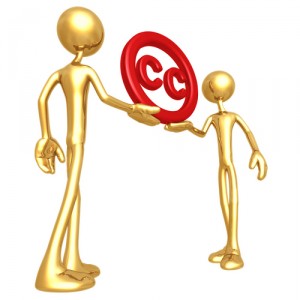The New Era of Copyrighting
 Copyrighting your original works is a good thing. It ensures that no one steals your intellectual property and profits from it. But the copyrighting process can be long, tedious and costly, with the original intent of protection often getting bogged down in the legal process. Now there is another choice that offers a streamlined process, yet ensures that the needs of all parties involved are being met.
Copyrighting your original works is a good thing. It ensures that no one steals your intellectual property and profits from it. But the copyrighting process can be long, tedious and costly, with the original intent of protection often getting bogged down in the legal process. Now there is another choice that offers a streamlined process, yet ensures that the needs of all parties involved are being met.
Creative Commons allows people to promote and market their intellectual property in a less restricted manner while still enjoying copyright protections that are necessary for their particular work. Anything traditionally covered under copyright law, including books, songs, films, videos, photographs, audio and visual recordings, websites, blogs and software documentation, is protected under a Creative Commons license. While this approach gives you more freedom with creative opportunities, you might still want to copyright your work for complete legal protection.
Creative Commons is a nonprofit Massachusetts corporation that provides free licenses and legal tools so a creator of intellectual property can easily indicate how the work can be used. Creative Commons offers three different license formats: Commons Deed, which is a summary of how the intellectual property can be used; Legal Code, which displays the legal wording of the actual license in its entirety; and Metadata, which contains the important elements of the license in machine-readable coding so it can be found by search engines.
With a Creative Commons license, you have the option of offering your work with “Some Rights Reserved” or “No Rights Reserved.” For example, you can allow your work to be shared, distributed, copied, or remixed by others as long as credit is given to you; give permission for remixes or adaptations of it with certain distribution restrictions; grant or restrict commercial use in which someone profits from your work; or allow full use in the public domain as is.
For online works, an html code is designated for your work and a license button and statement appears on your piece. Anyone who comes in contact with your work will be obligated to follow the terms you set under the license agreement. For published works not on the Internet, you can include a statement on the work or include a graphic of the license button, licensed statement and URL link.
An important feature of a Creative Commons license is its non-exclusivity. You can protect your work from unauthorized use in the public sector while maintaining the right to enter a separate non-exclusive license agreement to sell your work to an individual or company, or receive royalties from it. You can also decide to stop distributing your work at any time under a Creative Commons license.
With the evolution of technology encouraging the sharing of words, music and pictures to create new and better creations, a Creative Commons license is a welcome format for offering blanket protection for proprietary rights. It opens up a world of opportunities for co-sharing while honoring the rights of the creator.
Have you been using Creative Commons to adapt your work? We would love to hear what you have been doing with these rights – leave us a comment!
Adam Toren
